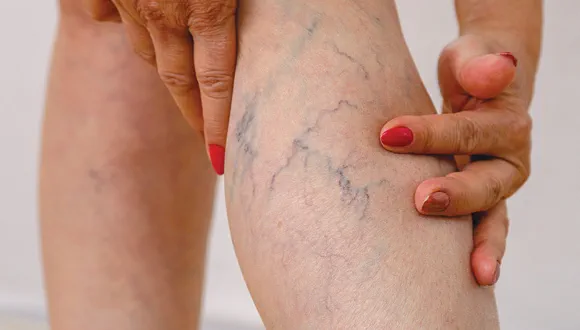
Varicose Veins
Varicose veins are swollen, bulging and twisted blue veins which are mainly caused due to raised pressure inside your veins as a result of leaking of valves. Factors such as hormonal changes, obesity, lack of physical activity, and pregnancy may increase the risk of varicose veins.
Clinical examination of the limbs is invaluable. A special ultrasound called Doppler Ultrasound is used to map the affected veins and to look for complications like deep vein thrombosis.
How are varicose veins treated?
Lifestyle changes
Certain changes in life style may help you control symptoms & progression of disease. These include:
- You can lose weight if you are obese
- Tight clothes which may hinder circulation should be avoided
- You can perform physical activity which increases blood circulation on a regular basis
- High-heels must be avoided as they put pressure on the calf muscles while walking which may hinder blood circulation
- Wear Compression Garments
Sclerotherapy is considered the best treatment for smaller spider and reticular veins. In this procedure an irritant solution is injected into the site of the veins. These veins become swollen and form a scar in a few days which gradually fades away. This therapy is simple quick and safe.
The endovenous method is a minimally invasive procedure which is performed for larger varicose veins. In this procedure a fine tube (catheter) is inserted into the vein till it reaches the affected area. The tube then emits a laser or radiofrequency waves which produce heat and form blood clots in the vessel. This blood vessel gradually shrinks and disappears. It is a quick procedure associated with early return to work.
Overview
Varicose veins are bluish, twisted visible veins, just below the skin, seen over your legs.
Common signs and symptoms of varicose veins include:
- Enlarged veins that are visible on your skin
- Mild swelling of your ankles and feet
- Painful, achy, or “heavy” legs
- Itchy legs
- Discoloration of your skin surrounding the varicose veins
Veins are blood vessels that take impure blood from the body to the heart. There are two systems of veins, one under the skin (superficial) & one in the muscles of the leg (deep veins). These are all connected through a series of channels called perforators. These have multiple valves which allow the blood to flow in one direction only. The direction of flow of blood is from foot to the heart & from superficial to deep veins. Any factors which cause damage to the valves can change the direction in which the blood flows. In your legs, this causes all the blood to flow back into the leg & pool. Over a period of time, this causes the stretching of the veins & they become visible & dilated.
Risk Factors
Genetics. Approximately half of the people who get varicose veins have a family history of them.
Age. The normal wear and tear of aging may cause valves to weaken and not work as well.
Gender. Women are two to three times more likely to develop varicose veins than men. Changes in hormones or taking birth control pills may increase a woman’s risk of developing varicose veins.
Pregnancy. During pregnancy, the growth of the fetus increases the pressure on the veins in the legs.
Overweight and obesity. Having extra weight on the body can put additional pressure on the veins.
Prolonged standing or sitting, When standing or sitting with legs bent or crossed, the veins have to work harder to pump the blood up to the heart.
How are the varicose veins diagnosed?
Varicose veins if visible are diagnosed clinically by your surgeon. A venous doppler is asked for, which is an ultrasound of your leg, to see the blood vessels, blood flow in them & status of valves & perforators. This also helps the surgeon know the site of defect in the veins & plan the surgery.
What are the general measures in treating varicose veins?
- Avoid excess amounts of standing when possible. Walking is good.
- Elevate your legs when sitting, resting, or sleeping.
- Wear compression stockings throughout the day.
- Lose weight.
- Avoid wearing tight clothes
What are the surgical measures?
Sclerotherapy. This involves several injections into the affected veins. A special chemical called sclerosant is used which obliterates the vein. This is followed by a compression dressing. This is good for small or residual varicosities. You may need several sittings.
Endovenous ablation therapy. A tiny tube or a catheter is introduced into the varicose veins & an energy source (laser or radiowave) is used to destroy the lining of the veins making it to close off. The procedure is carried out under doppler ultrasound guidance. Once the diseased veins close blood flows through veins with normally functioning valves.
Generally the surgery is either carried out as a daycare procedure & occasionally requires an overnight stay. Both the procedures are carried out in conjunction.
After the procedure the veins that were prominent become hardened initially and then gradually disappear over few months. Compression garments are recommended during this period.





